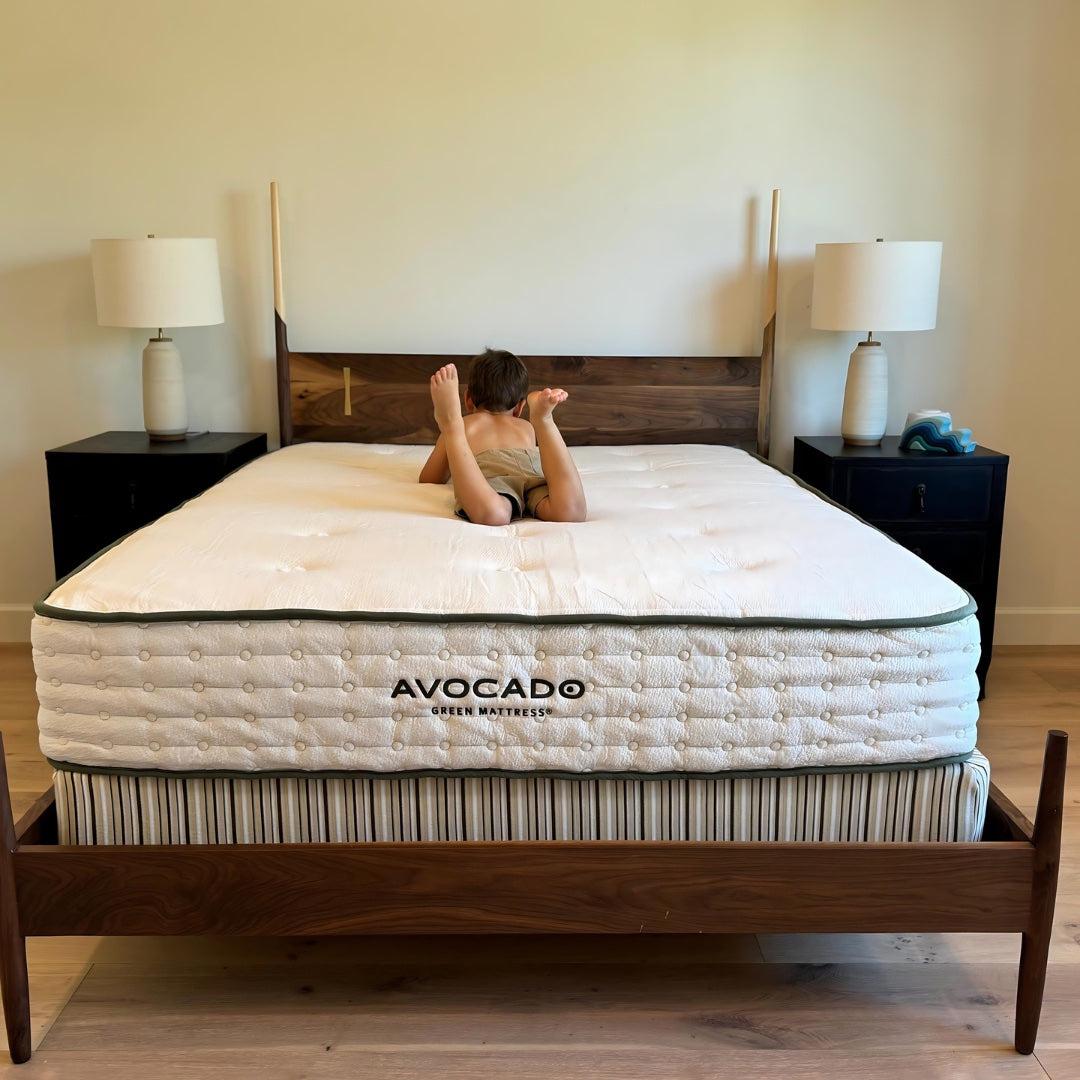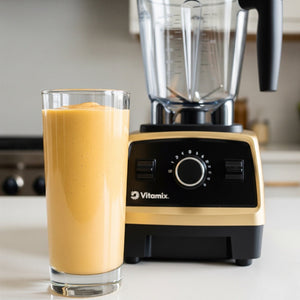Like most children, my boys spend around 10-12 hours a day in their beds! Sleep is crucial for growing brains and bodies. But does it matter what they sleep on? Yes! When you consider nearly half a child’s day is spent in bed, non-toxic bedding is a non-negotiable.
We recently transitioned my son Taschen to a “big boy bed.” I’m going to walk you through my process of building his non-toxic bed so you can have the knowledge you need to create a clean and cozy setup for your little ones, too!
Why a Non-Toxic Bed Is Important:
Our skin has about a 64% absorption rate of the toxins with which it comes into contact (source). That means whatever chemicals are being used to treat your mattress and bedding are being absorbed into your body when you sleep.
Some of the commonly found toxins in mattresses and on bedding come from:
- Synthetic fabrics - Studies suggest synthetic bedding is associated with asthma, allergies, and eczema. This may be because synthetic fibers and other chemicals are not only absorbed into the skin, but also breathed into the respiratory system. On the other hand, natural fibers can actually be protective (source).
- Flame retardants - Flame retardant exposure has been linked to preterm birth, cognitive deficits, behavior problems, and increased risk for asthma and allergies (source, source, source). Flame retardants are very commonly found on mattresses, duvets, bedding, and even pjs.
-
Volatile Organic Compounds (VOCs) - Mattresses can emit VOCs at harmful levels to children and infants. Research shows chemical emissions are worsened with body heat and strongest in the immediate breathing zone in bed (source).
- Harsh dyes - Harsh dyes can have skin-sensitizing effects, causing rashes and other skin irritations. Many dyes release amines, which are destructive to the skin barrier, and suspected to be carcinogenic, mutagenic, and genotoxic (source).
- Fragrances - Fragrances, either from your own laundry or from factory chemicals, can have negative skin, respiratory, and systemic effects like headaches, asthma-like symptoms, breathing difficulties, itchy eyes and runny nose, cardiovascular and neurological problems (source).
- PFAS, phthalates and other plastics including PVC and vinyl - These man-made “forever chemicals” don’t break down in the environment or the human body. They’re very commonly used in mattress protectors and mattress covers. They can emit dangerous VOCs, disrupt the hormone system, and lead to asthma-like symptoms.
Symptoms associated with toxins found in conventional mattresses and bedding include:
- Allergic reactions
- Eczema
- Rashes and dermatitis
- Itchy and watery eyes + post nasal drip
- Nasal and sinus congestion
- Respiratory problems such as difficulty breathing and allergic rhinitis
- Asthma and asthma-like symptoms
- Headaches
How to Choose Safe, Non-Toxic Bedding:
Thankfully, as consumers have become increasingly educated on the side effects of conventional bedding and all the chemicals that come with it, we’ve also seen an increase in options for clean, non-toxic options on the market. Many companies are committing to doing better for us and our children. Here’s what I look for in non-toxic mattress and/or bedding products:
- Choose 100% natural fibers for all bedding products. Natural fibers include: 100% cotton, linen, silk, bamboo, and wool. These allow your skin to breathe.
- Look for OEKO-TEX certification. This means the product has undergone rigorous testing for over 1,000 harmful substances by an independent laboratory to confirm its safety.
- Look for GOTS (Global Organic Textile Standard) certification. This ensures from the harvest of raw materials to the labeling and selling of the product, all steps in the process fall under strict organic and ethical standards.
- Look for MADE SAFE (Made With Safe Ingredients) certification. This means the product has been screened to ensure over 6,500 banned and/or restricted list substances have been avoided or constrained. It eliminates the most hazardous materials commonly found in home and daily use products.
- Avoid “mixed/blended” fabrics and synthetic fibers. This includes materials like satin, acrylic, nylon, or polyester. These are treated with chemicals and do not allow your skin to breathe. Additionally, they can contain plastics and other chemicals.
- Avoid chemically treated bedding. This includes materials containing any of the following labels: wrinkle-free, anti-static, easy-care, and shrinkage-free. These fabrics are treated with harsh chemicals and formaldehydes, which can result in subtle or extreme dermatitis flare ups among other symptoms.
- Finally, purchase your bedding from reputable companies whose standards, mission, and products are in alignment with yours! By supporting companies who are health-forward and transparent in both their processes and products, we are truly making our dollars count.
Building Taschen’s Bed: What I Chose & Why:
Now let’s make a bed! Keep in mind that the options I chose aren’t the only non-toxic options on the market, but they’ve been vetted and researched by me. So if you’re looking for easy answers, here you go!
1. Choose A Mattress:
- What to Look for:
- Made only out of high quality, natural components such as organic cotton, pesticide/chemical-free organic wool, or natural latex
- Certified GOTS and MADE SAFE
- Allergen-friendly with no flame retardants, formaldehyde, or foam
- My Recommendation: *Avocado Green The Ultimate Organic Mattress
- Made of organic latex, cotton, and wool without flame retardants or foams. This mattress is GOTS-certified, OEKO-TEX certified, and meets MADE SAFE standards.
2. Add a Waterproof Cover (optional, for accidents):
- What to Look for:
- Tested and free of PFAS (most waterproof toppers are made using some sort of plastic material for the waterproofing, which is what we want to avoid)
- Made with 100% natural organic cotton or wool
- Certified GOTS and MADE SAFE
- Allergen-friendly
- My Recommendation: *Avocado Green Organic Waterproof Mattress Protector
- Washable, breathable, non-toxic and waterproof! This mattress protector is free from plastics/PFAS, MADE SAFE certified, and topped with two layers of GOTS-certified 100% organic cotton.
3. Place a Wool Bolster (optional, for young children):
- What to Look for:
- Organic wool filling wrapped in organic, natural fibers such as organic cotton
- Certified GOTS and MADE SAFE
- Allergen-friendly
- My Recommendation: Holy Lamb Wool Filled Bumper
- Stuffed with organic wool that has been processed naturally without the use of harsh chemicals. Wrapped in 100% organic cotton. To use, place the bumper on the edge of your mattress or topper and add your fitted sheet over it to hold everything in place.
4. Use Kid-Friendly Pillows:
- What to Look for:
- Low profile for proper child/toddler neck support
- Filled with organic wool or made from natural latex
- Allergen and eco-friendly materials
- My Recommendation: *Turmerry Natural Latex Pillows
- Sized for babies and toddlers, these pillows provide proper neck support, are made of natural latex, and are allergen-friendly.
5. Personalize with Bedding – Duvet, Covers, Sheets:
- What to Look for:
- Natural fibers like organic cotton, linen, and bamboo for bedding
- Duvets that are filled with natural down or wool
- 100% organic, GOTS, and OEKO-TEX certifications when possible
- My Recommendation: *Cozy Earth or Parachute
- Cozy Earth has sheets and pillow covers in natural bamboo, linen, or silk (use code BEWELL for 25% off). Parachute also has great bedding options made from 100% organic cotton and/or natural linen made from 100% European flax.
BONUS - Bed Structure!
- Now that you have your beautiful, non-toxic mattress and bedding, we need to touch on where it’s going. The bed! Unfortunately many beds are made with paints, stains, glues, heavily-treated fabrics, and other materials that off-gas harmful chemicals into the air. If you’re in the market for a new bed (or purchasing something secondhand), here’s what to look for:
- Natural wood frame
- Zero-VOC glues
- Zero-VOC paints
- Water-based stains or Plant-based waxes/finishes
Resources:
- Be Well Podcast: Breathe Better, Live Better with NYT Best-Selling Author, James Nestor - The motivation you need to take your sleep to the next level via proper breathing. This podcast spills the surprisingly simple how-to’s.
- Be Well Podcast: Setting Your Kids Up for Sleep Success with Melissa Brown - Need a little more support for laying the groundwork for your kiddo to get great sleep? It’s all here.
- Laundry Detergent: Molly’s Suds and *Branch Basics - Keep your new bedding clear of chemicals by washing it with my favorite non-toxic laundry detergent.
*Please note, this page contains affiliate links, which means I may make a small commission at no additional cost to you if you purchase a recommended product via the link.






